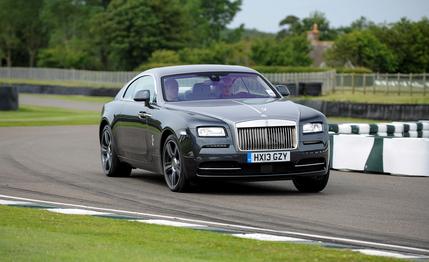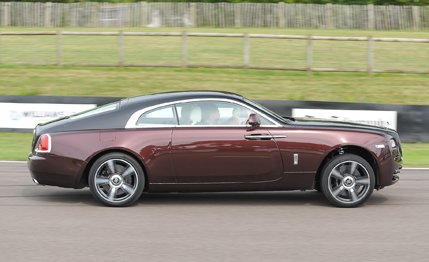 First Drive Review
First Drive Review
It is a historical curiosity that when Rolls-Royce first used the Wraith name way back in the late 1930s, the company sold only the running chassis. Independent coachbuilders supplied the bodies, built to reflect the owner’s particular (and sometimes peculiar) taste. These days, the new Wraith’s running gear traces its ancestry to corporate overlord BMW, while the body is the portion that defines a modern Roller as both distinct and distinctly British.
Odd, then, that the Wraith’s fastback roofline—the car’s defining feature—was cribbed from a couple of Italian cars. You see, Rolls has no precedent for a roofline that looks anything like this, so its designers couldn’t play the heritage card. According to design director Giles Taylor, the inspiration comes instead from the Lancia Aurelia coupe and the Maserati Ghibli (the original coupe introduced in 1967, not the recently introduced sedan of the same name). In profile, in person, this car looks spectacular and improbable. It’s such a massive and unexpected thing in any setting you can imagine. And it’s so gloriously space-inefficient, so unchained from the tedious priorities of regular cars. The sharp crease between the roofline and the brutal, bricklike shape of the lower body serves to make the Wraith one of few modern cars that looks totally appropriate in a two-tone paint job.

Contrasting paint notwithstanding, the new Wraith has been cast as the performance-minded Rolls-Royce, though the company is eager to add that the Wraith is no sports car. So just in case you thought a 5500-pound, 17-plus-foot-long vehicle with power-operated doors was a sports car, know that you would be wrong. The Wraith’s 624-hp twin-turbocharged V-12 is the most powerful engine offered in any of the company’s cars, and we expect that it will carry the Wraith to 60 mph from a standstill in 4.3 seconds. And it will do so with a measured thrum from the exhaust that only plays background to whatever soundtrack you’ve chosen to pipe through the Naim audio system.
It’s more powerful and quicker than the Ghost sedan, which served as the donor car for this monstrous coupe. The company chopped more than seven inches from the Ghost’s wheelbase to create the Wraith. But, at 122.5 inches, the coupe’s wheelbase is still longer than that of a Chrysler 300.
This, along with an overall width greater than most mid-size SUVs (76.7 inches) and a steering wheel the size of a manhole cover, makes the Wraith feel predictably enormous. The sensation was exacerbated by our test route, made up largely of English country lanes. To our consternation, they appeared to be only about the width of 1.2 Wraiths.
Yet you pretty quickly get used to guiding this blunt-nosed boat using a light touch on the thin-rimmed wheel. Despite the BMW origins of its mechanical bits and the fact that its chassis was tuned by a man named Peter Kunzinger (who also tuned the BMW Z8 in an earlier life), the Wraith’s deportment is sort of the antithesis of stereotypical German tuning. Its steering is light and friction-free, though still accurate and tactile. And the mien of its suspension (which consists of multilink front and rear wheel attachments, air springs, electronically controlled dampers, and automatically adjusting anti-roll bars) is likewise free and easy.
The big body is allowed to move around a bit, front to rear and side to side, but it doesn’t bob or wallow. It’s all very gently controlled. And despite wearing 45-series tires up front and 40-series in the back, the Wraith doesn’t trouble its passengers with small, high-frequency impacts. In fact, to our backsides, the Wraith’s ride quality felt better than that of its bigger, less sporty brother, the Ghost sedan.